← Back to “Ask The SCI Expert” Series
Our new newsletter series “Ask The SCI Expert” highlights a particular popular topic in Spinal Cord Injury Research and our experts answer the most common questions regarding the topic. This month we are discussing Brain and Spine Implants in persons with Spinal Cord Injuries’ with Dr. Noam Harel.

Headlines were made around the world recently when a lab in Switzerland published an article about using brainwaves to control an implanted spinal cord stimulator: “Walking naturally after spinal cord injury using a brain–spine interface”.
This combined device has been used in one person so far. A 38-year-old man with chronic C5-C6 incomplete SCI. See this link for a video of him using the device.
Q: What is a brain-spine interface?
A: This system has two parts: The brain interface is surgically implanted inside the skull. It can detect electrical activity coming from the surface of the brain (the cortex) while it thinks about walking. The brain interface does NOT stimulate the brain. It just records brain electrical activity. The spine interface is a surgically implanted epidural stimulator in the lower back. It receives signals from the brain interface via an external computer processor. The computer tells the spine implant how to deliver its electrical stimulation to nerves controlling different leg muscles during walking.
Q: Is it wireless?
A: NO! Not really. The brain interface can send its recording data wirelessly using EXTERNAL antennas mounted on top of the head to an EXTERNAL computer mounted on a walker or a backpack. The external computer then sends instructions wirelessly to the implanted pulse generator (implanted under the skin near the belly). The implanted pulse generator then sends signals/power to the epidural stimulator through a wire threaded under the skin. So there is a combination of multiple internal and external parts and wires.
Q: Is this a cure for SCI?
A: No unfortunately. This is more of a computer-assisted digital bridge across an injury, not really a biological cure for injury. For the foreseeable future, the best treatments for SCI will improve nerve circuit ‘plasticity’. In combination with stimulation and exercise, plasticity can lead to improved function.
Q: What are the risks?
A: Because this requires 3 different surgical implants (brain interface, spinal interface, and the internal power generator), there is a risk of surgical complications – especially bleeding and infection. Because it requires brain surgery, there is a further risk of brain damage resulting in weakness, difficulty speaking, and/or seizures. There is also a risk that the technology does not work properly in every person. And you need to be aware that once you get an experimental implanted device, you would not be eligible to participate in most future research studies of future-generation implants.
Q: Where can I get one?
A: This has been the only brain-spine interface used so far in the world, under a regulated (and very expensive) research study in Switzerland. The technology is still being developed. Unfortunately, you can’t get this placed anywhere else at this time.
Q: What can I do to prepare for this technology?
A: Doing everything you can to keep yourself in the best medical condition possible will improve your body’s ability to respond to new treatments as they are developed. Also, it may not always seem fair, but most medical research trials seek to enroll people with SCI who have as few complications as possible. So it’s important to keep your skin intact and your limbs stretched.
